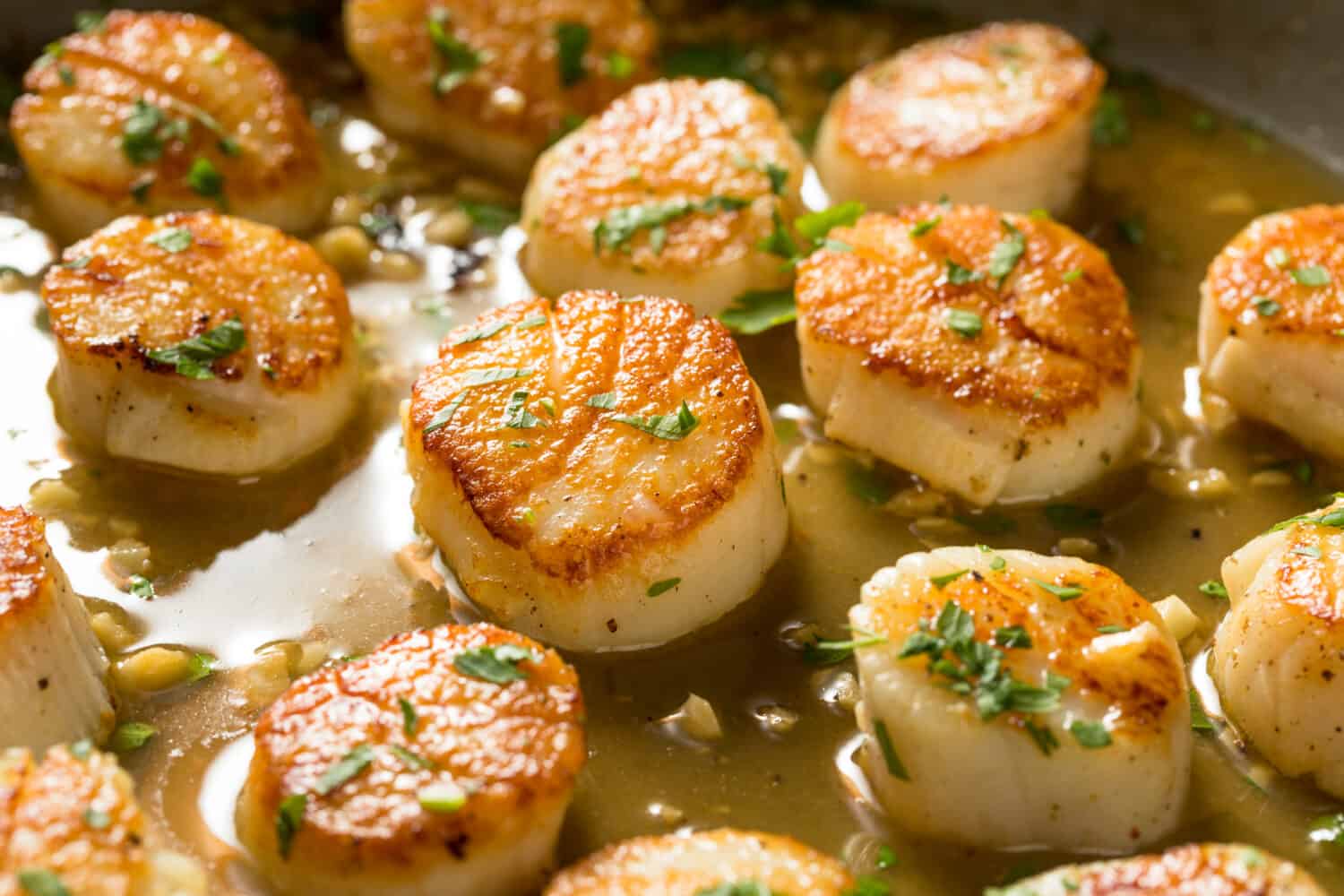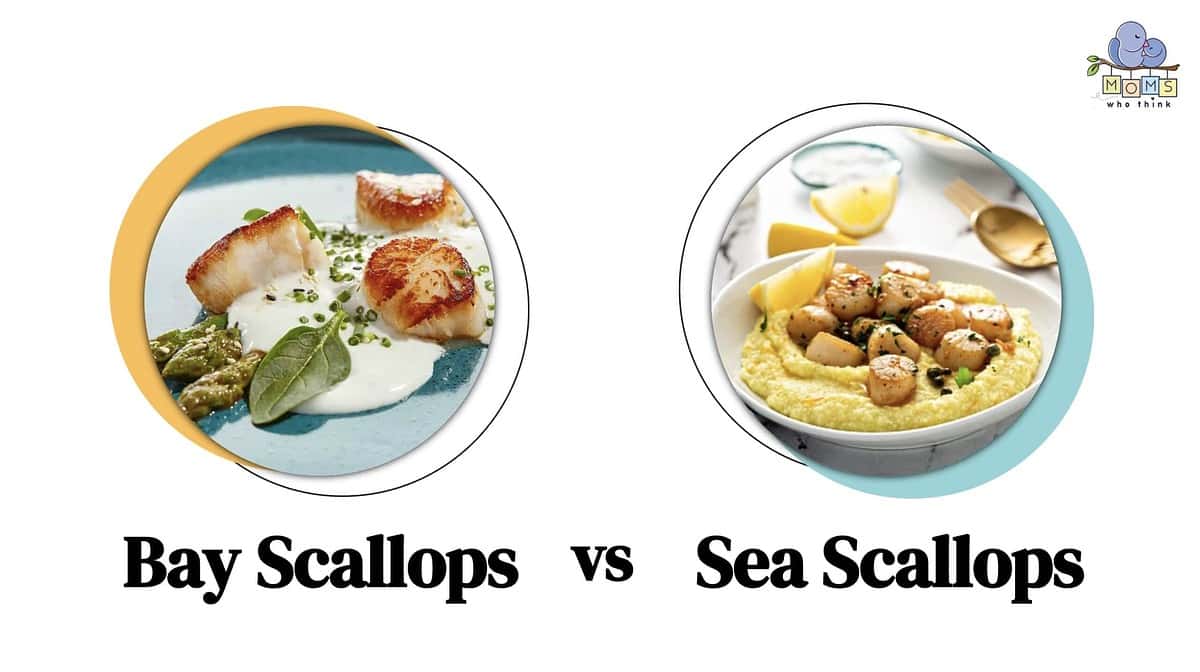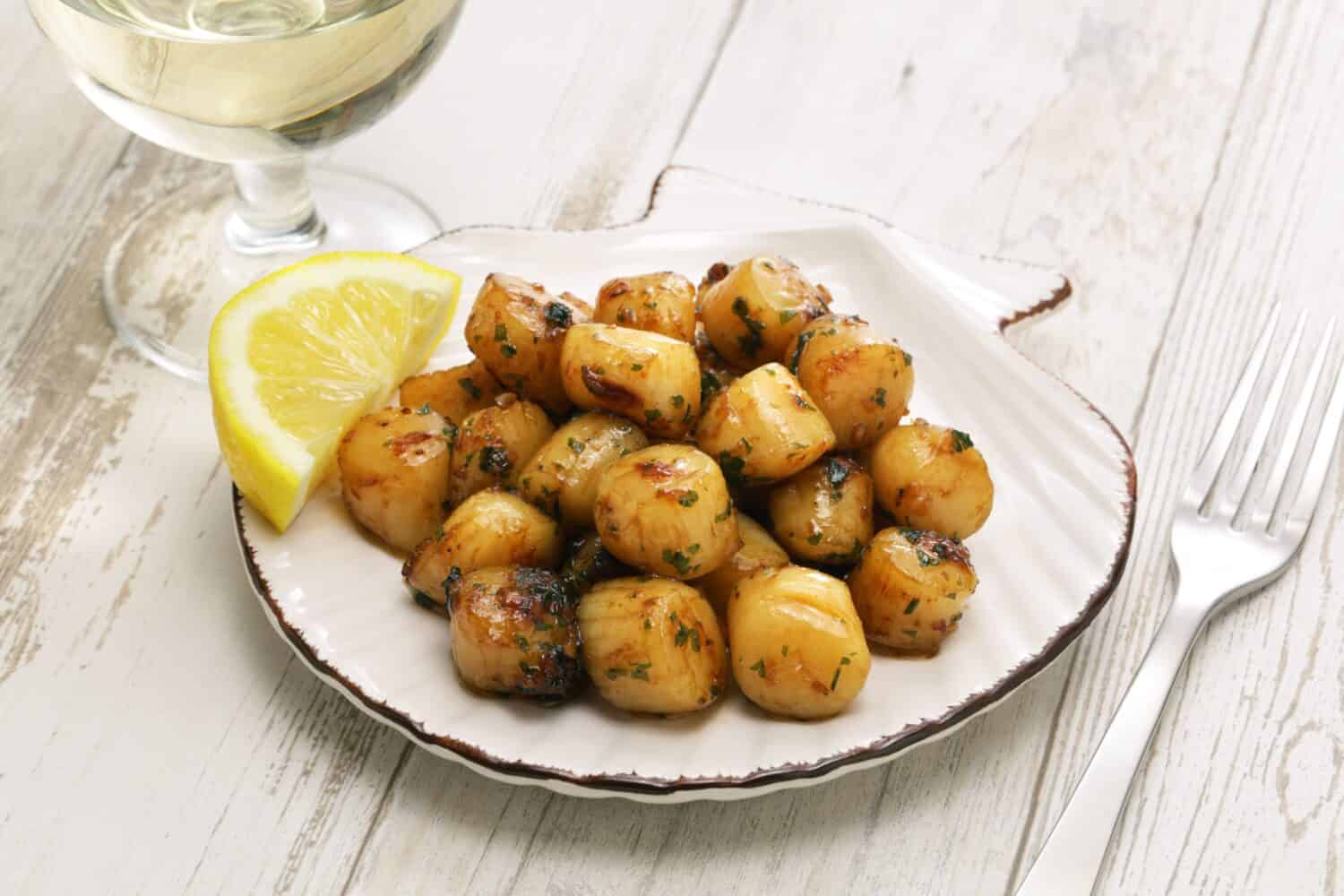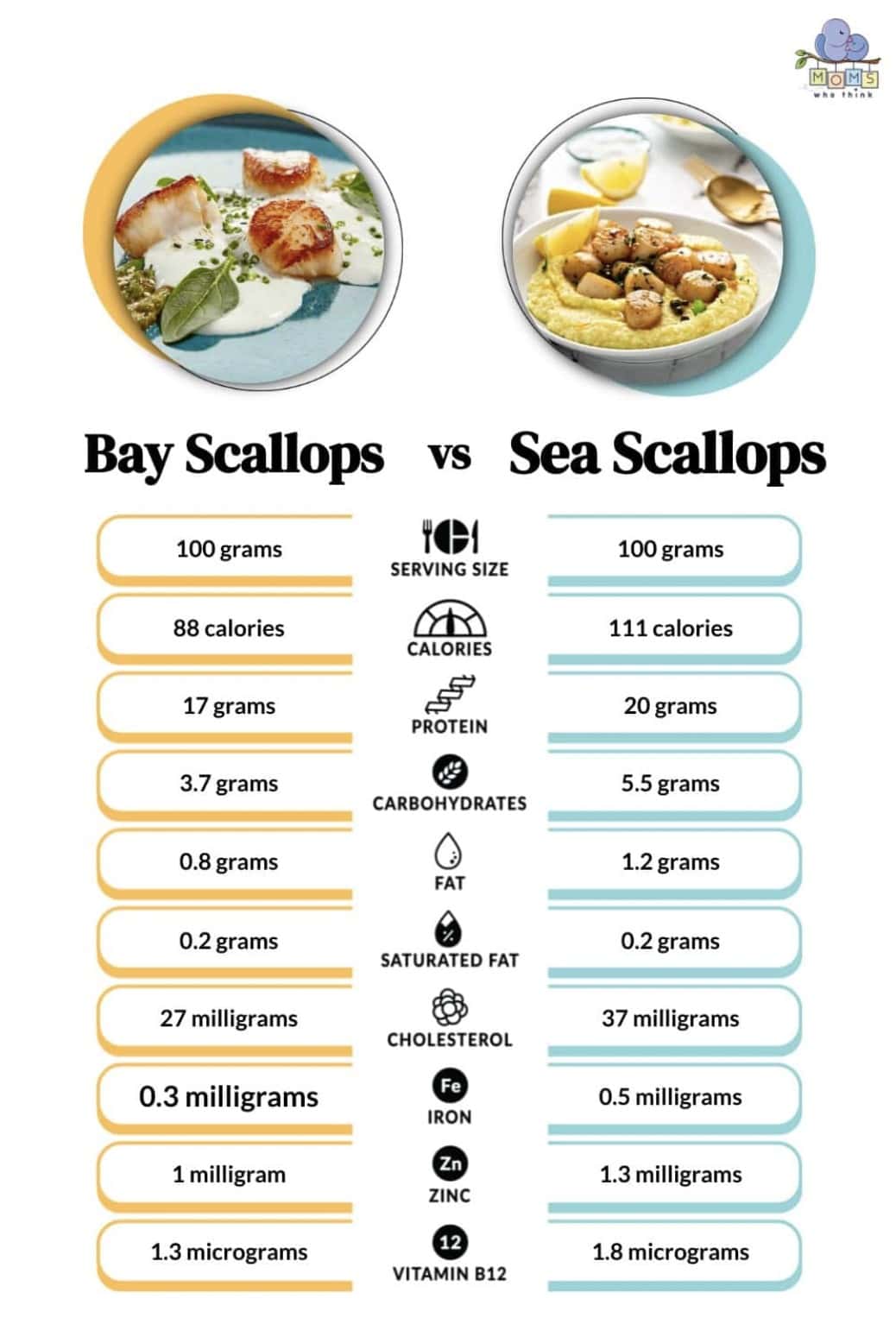

Bay Scallops vs. Sea Scallops: 4 Key Differences Including Taste & Texture
Scallops, or bivalves, are a class of mollusks alongside mussels, clams, and oysters. Have you ever stopped at a grocery store and wondered about the difference between bay scallops vs. sea scallops? Or maybe you've just wondered about the origins of scallops in general, you’re reading the right thing! While the name may suggest a habitat difference between bay scallops vs. sea scallops, the two also differ in size, taste, and texture. They are also cooked in different kinds of recipes, often due to their availability. These two do belong to the same Mollusca phylum. However, they really are quite different in enough ways to be unique on their own (via Brittanica). Let's learn more about it.
In this post, we’ll discuss the history of bay scallops vs. sea scallops. We'll also take a look at how they’ve evolved over time. You’ll learn about where their differentiating traits came from, and get some ideas on the best recipes for either kind of scallop. Come dinnertime, you’ll be a pro at discerning how the size, texture, taste, and origins impact the usability of bay scallops vs. sea scallops. Hunker down as we get into the delicious details of these bivalves and their uses.

Bay Scallops vs. Sea Scallops: What Is The Difference?
The differences between bay scallops vs. sea scallops come down to the taste, texture, size, and where they are grown. While bay scallops grow in shallow waters, sea scallops are typically found in deeper, chillier waters. Sea scallops are much larger than bay scallops. Their size contributes to a thicker skin which impacts their overall texture in comparison. Where they are grown also influences the flavor of bay scallops vs. sea scallops. Bay scallops are generally described as sweeter while sea scallops have a briney, salt tinge to them. It makes sense if you think about the conditions in which they are grown.
What Are Bay Scallops?
Bay scallops (Argopecten irradians) are naturally occurring bivalves. They thrive in warmer, shallow water along areas like the Atlantic coast of the United States. We'll get a bit more into their history in a second. Bay scallops are extremely sensitive to environmental shifts. This means that the slightest change to their natural growing habitat can wreak havoc on the bay scallop population.
Bay scallops are a part of the phylum Mollusca. They are called a bivalve because they have two valves (shells) which are joined in the middle by a hinge of sorts. Bay scallops feed on algae and organic matter around them, opening their shells to feed, as well as to breathe. They also use this motion to escape predators when the need arises. As mentioned before, they are smaller, sweeter, and less tough, in terms of texture than their deep-water sea scallop cousins. In the wild, they live a maximum of 2 years (via Florida Fish & Wildlife Conservation).
History And Origin of Bay Scallops
Versions of bivalves have existed for thousands of years. However, the modern iteration of Bay scallops is native to the Northwest Atlantic coast. The growing ground stretches from Massachusetts Bay towards the Gulf of Mexico. Some specimens have been found around Nova Scotia, but this is not an established breeding ground for bay scallops. There are mentions of the bay scallop in texts dating back to 1963 and 1973 in San Francisco, and as early as 1923 in coastal areas of Oregon. There are theories that bivalves evolved in these waters as the result of discarded bivalve shells transported from the Long Island Sound in the 1800s or 1900s. They have been bred in other parts of the world, however, the largest production of bay scallops happens in areas including Massachusetts, and Florida (via Smithsonian Institution).

©bonchan/Shutterstock.com
Popular Recipes For Bay Scallops
Because of their size, and their tenderness, bay scallops are very easy to cook. The typical way to prepare bay scallops is to sauté them in some kind of oil, although butter is also a popular option. They can be seared, which is the common way to prepare sea scallops, but because bay scallops are so much smaller, usually sautéing them will do just fine. Try preparing them as a tender side dish to heartier meats, soups, or stews, and throw in some vegetables while you're at it.
Check out some of these sauté recipes involving bay scallops:
- Bay Scallops with Garlic Parsley Butter Sauce
- Sauteed Bay Scallops with Lemon Butter
- Bay Scallops Provençal
Bay scallops can also be chopped up raw and put into a ceviche. Due to their size, and sweetness, they will blend easily with the other flavors and don't take all that much preparation in a raw dish of this kind.
What Are Sea Scallops?
Sea scallops encompass a few different varieties, but they are generally found in deep-sea, cold-water environments. Sea scallops can grow up to 2 inches, which sets them apart from the much smaller bay scallops. Due to their harsher environment, they tend to be tougher in texture, and saltier to taste. Also, a bivalve, sea scallops are harvested for their meaty muscle, the round white thing that is cooked with butter and considered a delicacy in many regions in which it is consumed.
Unharvested sea scallops can live up to 20 years, with a very fast growth pattern during the first few. The Atlantic sea scallop grows in areas throughout the Northwest Atlantic Ocean, all the way to the Northern Carolina coast and Canada. According to NOAA Fisheries, the greatest U.S. yield for the Atlantic sea scallops comes from Virginia, New Jersey, and Massachusetts. Principal commercial fisheries are in areas of Virginia, Long Island New York, and the Gulf of Maine.

©Brent Hofacker/Shutterstock.com
History and Origin Of Sea Scallops
Similar to bay scallops, sea scallops have ancestral bivalve organisms that date back millions of years. Predesedors of scallops have been found in the fossilized stomachs of animals, and humans, well before civilizations were organized or food was properly named. They can be traced globally. In historical Europe, they have been depicted in paintings from ancient Rome. Scallops are also used in traditional French, Dutch, and Polish recipes that date back very far. The scallop is cultivated in parts of Asia, with modern farming technology helping Japanese fisheries to increase their scallop production between the 1900s-1960s. In the States, scallops made their rounds through travel and trade, first for their pretty shells, then for the sweet muscle interior. Scallop farming developed around New England and spread along the coast (via Fire And Ice).
Popular Recipes For Sea Scallops
One of the most popular ways to prepare sea scallops is by searing them. This creates a delicious crust and doesn't require the same time for sautéing tough meat of this kind. Searing retains the juicy taste of the scallop without overdoing it, and given the size, it's one of the easier ways to cook sea scallops. Add some butter, or include it with some vegetables. Check out these recipes involving sea scallops:
- Stir-Fried Scallops and Asparagus Recipe
- Sea Scallops With Brown Butter, Capers, and Lemon
- Easy Garlic-Lemon Scallops
Nutritional Value Comparison of Bay Scallops vs. Sea Scallops
As you can see from the chart below, the size of the scallop impacts its nutritional profile. Sea scallops are higher in calories, protein, and fat. Both types can be rich in fiber, and a great source for certain vitamins and minerals. According to Web M.D. scallops are among the healthiest of seafoods, with a higher protein than fat content, they are chock full of antioxidants that might benefit heart health, and protect against certain chronic diseases. It's always good to research the kinds of foods you're eating, but generally, scallops are a great dietary staple, especially in terms of protein.

Possible Alternatives To Bay Scallops And/Or Sea Scallops
Before you swear off scallops entirely, try some of the other varieties of sea scallops. These include Calico scallops which are smaller than bay scallops and harvested from warm water habitats, and Patagonian scallops which come from the coast of Argentina. For more Mollusca options, try out oysters, clams, and mussels. Completely unrelated to scallop alternatives include shrimp and prawns which can have a similar texture and taste when prepared in similar dishes. Monkfish is also a good scallop alternative if you're looking for fish without the bivalve relation.